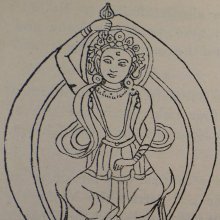Navel: 3 definitions
Introduction:
Navel means something in Hinduism, Sanskrit. If you want to know the exact meaning, history, etymology or English translation of this term then check out the descriptions on this page. Add your comment or reference to a book if you want to contribute to this summary article.
Images (photo gallery)
(+35 more images available)
In Hinduism
Gitashastra (science of music)
Source: Shodhganga: Elements of Art and Architecture in the Trtiyakhanda of the Visnudharmottarapurana (gita)The Navel (in Sanskrit: Nābhi) refers to one of various Organs of Utterance (sthāna), according to the Saṃgītaratnākara.—During the practise of Vocal Music, the proper production of the concerned sound is always considered as very important. Sthāna or ucchāraṇasthāna is the place of articulation of sound. Bhattojidīkṣita in his Siddhāntakaumudī said about ten kinds of sthāna (i.e., the organs of utterance), e.g., nābhi (navel).
Gitashastra (गीतशास्त्र, gītaśāstra) refers to the ancient Indian science of Music (gita or samgita), which is traditionally divided in Vocal music, Instrumental music and Dance (under the jurisdiction of music). The different elements and technical terms are explained in a wide range of (often Sanskrit) literature.
Shilpashastra (iconography)
Source: Shodhganga: Elements of Art and Architecture in the Trtiyakhanda of the Visnudharmottarapurana (shilpa)The Navel is denoted by the Sanskrit term Nābhi, and represents one of the various body parts whose Measurements should follow the principles of ancient Indian Painting (citra), according to the Viṣṇudharmottarapurāṇa, an ancient Sanskrit text which (being encyclopedic in nature) deals with a variety of cultural topics such as arts, architecture, music, grammar and astronomy.—In the third part of the Viṣṇudharmottarapurāṇa, chapters 35th to 43rd are dedicated to the Painting of different portraits of different kinds of men and women. The measurement of almost all the body parts that should be maintained in a picture have been presented here. For example, the Navel (nābhi) should be 12 aṅgulas.

Shilpashastra (शिल्पशास्त्र, śilpaśāstra) represents the ancient Indian science (shastra) of creative arts (shilpa) such as sculpture, iconography and painting. Closely related to Vastushastra (architecture), they often share the same literature.
Yoga (school of philosophy)
Source: ORA: Amanaska (king of all yogas): A Critical Edition and Annotated Translation by Jason BirchThe Navel is denoted by the Sanskrit term Nābhi, according to the Kubjikāmata verse 25.130.—Accordingly: For one who has remembered [the sound of] the ḍamaru [drum] in the no-mind [state], which is free of ills, Kuṇḍalinī, in the form of Māyā, remains situated in the navel (nābhi)”.

Yoga is originally considered a branch of Hindu philosophy (astika), but both ancient and modern Yoga combine the physical, mental and spiritual. Yoga teaches various physical techniques also known as āsanas (postures), used for various purposes (eg., meditation, contemplation, relaxation).
See also (Relevant definitions)
Starts with: Navela, Navele, Navelumpu.
Ends with: Konavel, Waternavel.
Full-text (+825): Nabhi, Manipura, Nabhila, Nabhya, Padmanabha, Tundi, Nabhika, Muladhara, Tundika, Romavali, Romali, Bombi, Nabhikantaka, Nabhidaghna, Urnanabha, Bharma, Udaravartta, Nabhikamala, Mriganabhi, Tundila.
Relevant text
Search found 197 books and stories containing Navel; (plurals include: Navels). You can also click to the full overview containing English textual excerpts. Below are direct links for the most relevant articles:
The Garuda Purana (by Manmatha Nath Dutt)
Chapter LXV - Auspicious marks on men and women as disclosed by the science of Samudrikam < [Agastya Samhita]
Chapter LXIV - A brief discourse on the auspicious or in auspicious marks on the person of females < [Agastya Samhita]
Chapter LX - Discourses on the period of influences of the different planets with that of the sun < [Agastya Samhita]
Animal Kingdom (Tiryak) in Epics (by Saranya P.S)
The Devi Bhagavata Purana (by Swami Vijñanananda)
Chapter 3 - On the origin of Brahmā, Viṣṇu, Maheśa and others < [Book 9]
Chapter 3 - On the description of the Kavaca of Śrī Gāyatrī Devī < [Book 12]
Chapter 2 - On cleansing the several parts of the body < [Book 11]
Rig Veda (translation and commentary) (by H. H. Wilson)
Trishashti Shalaka Purusha Caritra (by Helen M. Johnson)
Part 3: Personal description of of Ajita and Sagara < [Chapter III - The initiation and omniscience of Ajita]
Part 5: Birth rites of Sambhava < [Chapter I - Sambhavajinacaritra]
Part 3: Ananta’s parents < [Chapter IV - Anantanāthacaritra]
Bharadvaja-srauta-sutra (by C. G. Kashikar)
Related products






